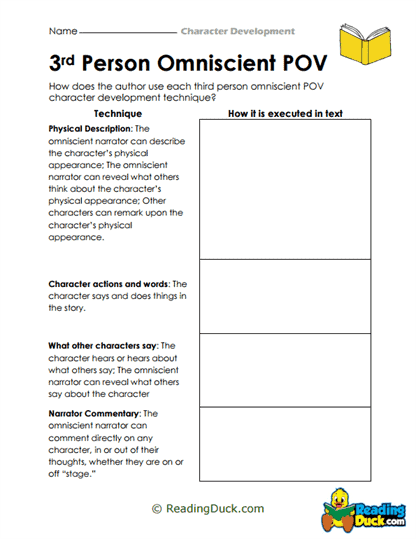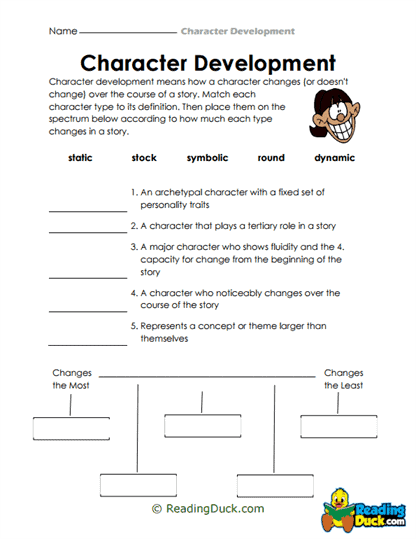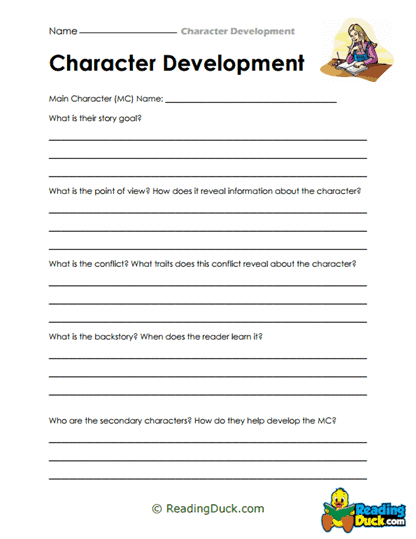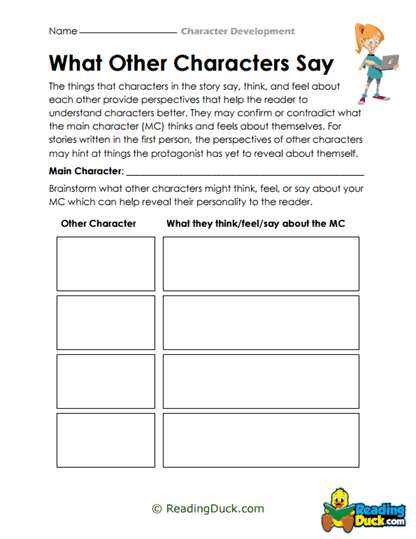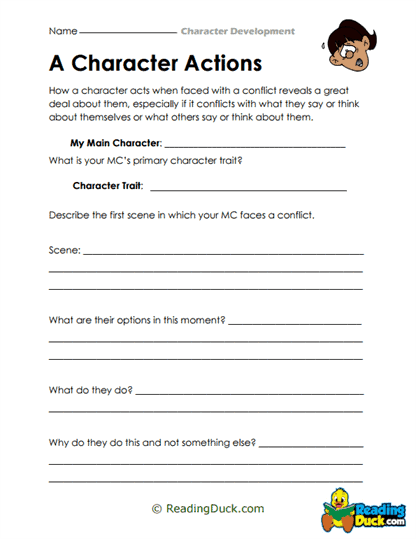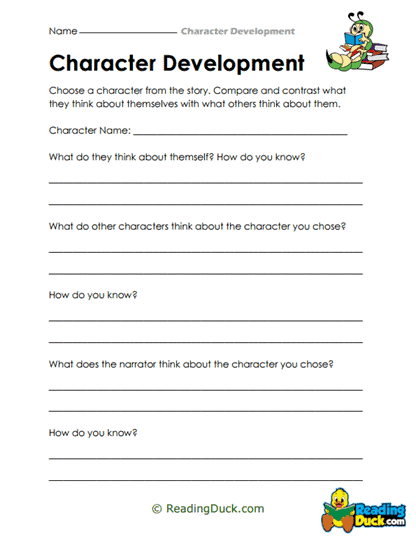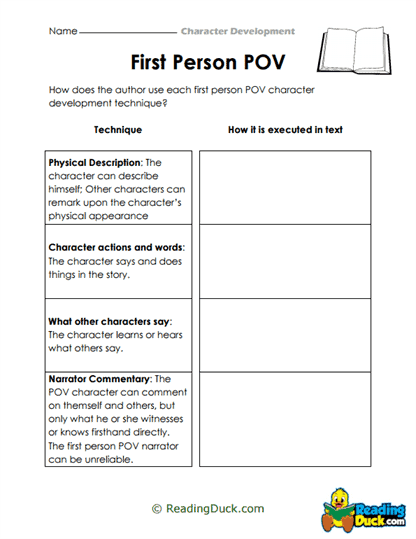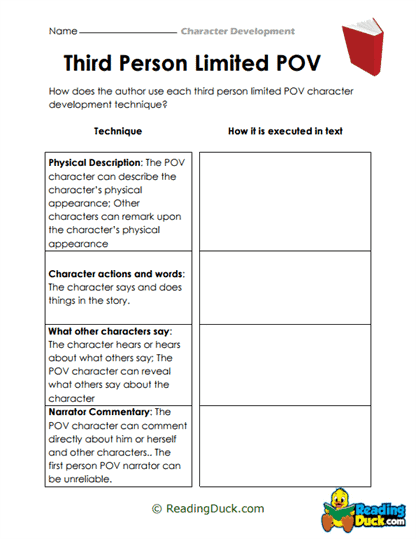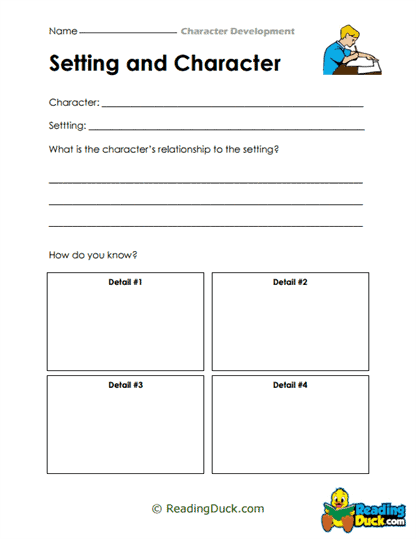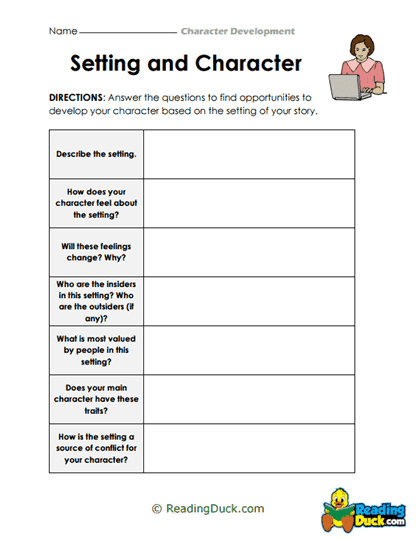Character Development Worksheets
About Our Character Development Worksheets
Our Character Development Worksheets are designed to help students master the essential skill of creating rich, dynamic characters in their writing. Character development is a critical aspect of storytelling, enabling writers to craft engaging narratives that resonate with readers. This collection of worksheets guides students through the process of developing well-rounded, believable characters, starting with foundational exercises and progressing to more complex tasks.
These worksheets are provided in PDF format, making them easy to download, view, and print for classroom or home use. Each worksheet also includes a downloadable answer key, ensuring that educators and parents can effectively assess student progress. Whether used as a central component of a writing unit or as supplemental activities, these worksheets offer a hands-on approach to improving students’ understanding of character development in a variety of writing contexts.
Understanding Character Development
Character development is the process of creating a character that grows, evolves, or changes over the course of a story. In writing, characters are often the driving force behind the plot, and well-developed characters make stories more engaging and relatable. Good character development helps readers connect emotionally with the story and understand the motivations behind a character’s actions.
When teaching character development, it’s essential to start with the basics:
- Character Traits: These are the building blocks of character development. Students learn how to identify and describe physical traits (appearance), emotional traits (feelings and motivations), and behavioral traits (actions).
- Character Backstory: This involves creating a history for the character that informs their personality, decisions, and motivations in the story. For example, if a character grew up in a challenging environment, it might explain their determination or their distrust of others.
- Character Arcs: A character arc refers to the transformation or growth a character undergoes during the story. In a story like The Lion King, Simba evolves from a carefree cub to a responsible king. Teaching students how to develop a character arc helps them understand that characters should change and grow as the story progresses.
Real-world applications of character development can be found in many areas outside the classroom. For instance:
- Public Speaking: When crafting a speech, students can use character development principles to build compelling, relatable personas that engage their audience.
- Personal Storytelling: Whether in college essays or social interactions, understanding how to present oneself or others with depth and complexity can help in various personal and professional scenarios.
- Creative Writing: For students interested in pursuing careers in creative writing, film, or theater, mastering character development is essential for producing captivating stories.
Scaffolding for Progression and Mastery
Our worksheets follow a scaffolded approach, which means they are structured to gradually build a student’s skills from basic to more complex tasks. This step-by-step learning process ensures that students can confidently master character development while improving their overall writing abilities.
Here’s how the scaffolding works within our worksheets:
- Foundational Skills: Students start with simple exercises like identifying character traits and creating basic character profiles. These worksheets focus on getting students to think critically about what makes a character unique. For example, they might list adjectives to describe a character's personality or sketch a character's physical appearance.
- Exploring Motivations and Conflicts: Once students have a basic understanding of their character’s traits, they progress to exercises that explore the character’s motivations and conflicts. Worksheets in this section guide students to think about questions such as, "What does this character want?" or "What internal and external obstacles do they face?"
- Building a Backstory: Worksheets will ask students to create a backstory for their characters. For example, if a student is developing a character who is a shy teenager, they might explore the events in that character’s childhood that shaped their personality.
- Character Arcs: More advanced worksheets introduce the concept of a character arc, helping students understand how characters change over time. Students will work on developing a plan for how their character grows emotionally or psychologically by the end of the story.
- Synthesis and Application: The final worksheets in the series guide students in applying all the character development skills they’ve learned to create fully developed characters within a story. These tasks might involve writing scenes where the character’s traits and motivations come into play or outlining a character’s journey from the beginning to the end of the narrative.
Supporting Teachers and Parents in Assessing Progress
To help teachers and parents assess student progress, each worksheet comes with a downloadable answer key. These keys provide guidance on what to expect from students’ responses, making it easier to evaluate their understanding of character development concepts.
Tips for evaluating student performance:
- Completeness of Character Profiles: Look for students to include detailed descriptions of both physical and emotional traits. A well-rounded character should feel believable and consistent throughout their profile.
- Clarity of Motivations and Conflicts: Assess whether students have clearly defined what their character wants and what obstacles stand in their way. This will ensure the character’s journey feels purposeful and engaging.
- Coherence of Character Arcs: When evaluating advanced worksheets on character arcs, check if the student’s character shows growth or change over the course of the story. A strong character arc should reflect a natural progression based on the character’s motivations and challenges.
Teachers and parents can also encourage students to self-assess by reflecting on their character development choices. By reviewing their worksheets and comparing their character’s initial traits with how the character evolves, students can gain deeper insights into their creative decisions.
Adapting for ESL Learners and Students Needing Extra Support
Our Character Development Worksheets are designed to be accessible to all learners, including ESL students and those who may need additional support with writing. These worksheets break down complex concepts into manageable tasks, making it easier for students to grasp key ideas while building confidence in their writing.
Strategies for supporting diverse learners:
- Simplified Language: Start ESL students with worksheets that focus on basic character traits, using clear and concise language. For instance, students might be asked to describe a character using a list of pre-selected adjectives such as “brave,” “curious,” or “kind.”
- Sentence Starters: Provide sentence starters to help students construct responses. For example, a worksheet might begin with, “My character is motivated by…” or “One challenge my character faces is…”
- Visual Aids: Encourage students to use visual aids like character sketches or mind maps to organize their thoughts. These tools can help students, particularly visual learners, clarify their ideas before they start writing.
With these adjustments, educators can ensure that all students, regardless of their language proficiency or learning needs, can successfully engage with the material and develop strong characters.
Adapting for Different Skill Levels and Classroom Settings
One of the greatest strengths of our Character Development Worksheets is their adaptability for various skill levels and classroom settings. Whether students are just beginning to learn about character development or are ready for advanced creative writing tasks, the worksheets can be tailored to meet their needs.
For Beginners:
- Use the worksheets to introduce the basics of character development, focusing on identifying traits and creating simple character profiles. This approach helps students build a foundation before tackling more complex writing tasks.
For Advanced Learners:
- Challenge students to create dynamic character arcs or explore deeper psychological motivations. These students can also be tasked with applying their character development work to longer writing projects, such as short stories or novels.
Flexible Classroom Use:
- Independent or Group Work: The worksheets can be used for individual practice or as part of group activities where students collaborate to develop characters for a shared story.
- Main Resource or Supplement: Whether used as the core instructional tool for a character development unit or as supplemental material for creative writing lessons, the worksheets fit seamlessly into a variety of teaching strategies.
Engaging Students with Practical, Hands-On Learning
Our Character Development Worksheets provide students with a practical, hands-on approach to crafting well-rounded characters. By guiding learners from foundational concepts to more advanced writing tasks, these worksheets help students gain a deep understanding of what makes characters come to life in a story. With easy-to-use formats, clear instructions, and downloadable answer keys, these worksheets are valuable resources for teachers, parents, and students alike.
By mastering character development, students not only improve their creative writing skills but also gain insights into human behavior, storytelling, and communication. Whether in the classroom or at home, our worksheets provide a flexible, engaging way to help students develop characters that resonate with readers and enhance their overall writing abilities.
